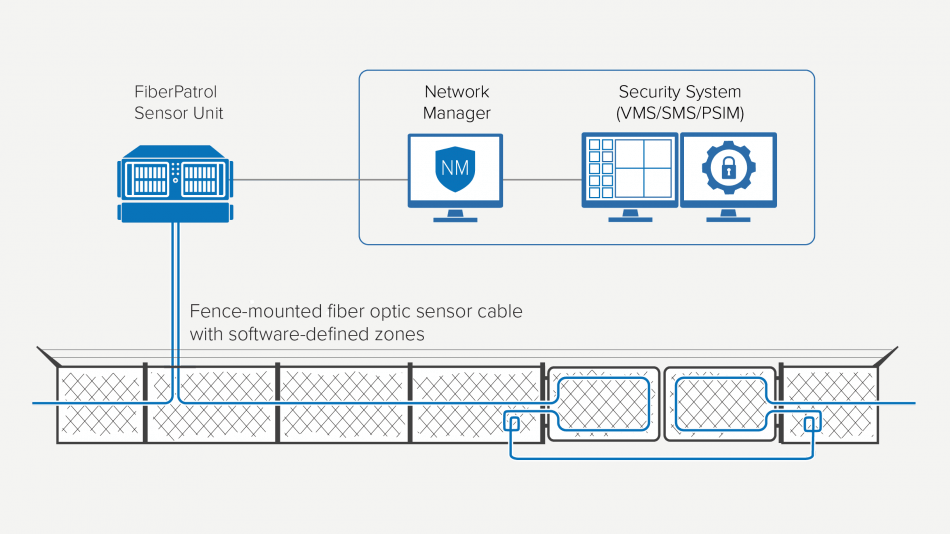Boost Your Security With Advanced Fiber Optic Security Systems
In a period where security is paramount, sophisticated fiber optic protection systems offer an engaging service for boosting safety and security across various atmospheres. What effects do these improvements hold for future safety steps?
Advantages of Fiber Optic Security
Harnessing the advantages of fiber optic modern technology significantly boosts safety and security systems throughout numerous applications. Among the key advantages is the enhanced bandwidth ability, enabling for the transmission of large quantities of information at high speeds. This is particularly crucial for real-time video surveillance, where high-resolution feeds can be sent without latency, guaranteeing prompt reaction capacities.
Additionally, fiber optics show premium resistance to electro-magnetic disturbance, which is important in environments with prospective signal disturbances. This dependability makes sure regular performance in vital security procedures. Furthermore, fiber optic cables are less susceptible to tapping and unauthorized gain access to compared to conventional copper wiring, thus boosting data stability and privacy.
One more noteworthy benefit is the durability of fiber optic systems; they are a lot more immune to environmental elements such as dampness, temperature level variations, and destructive materials. This strength equates to lower upkeep prices and longer life expectancies for safety and security setups.
Lastly, the light-weight nature of fiber optic cables helps with simpler installation and routing, particularly in complex facilities (fiber optic security system). Eventually, the assimilation of fiber optic modern technology right into protection systems not only bolsters security procedures however additionally optimizes operational efficiency
Secret Functions to Take Into Consideration
When examining fiber optic security systems, several essential features must be considered to guarantee optimal performance and effectiveness. Initially, evaluate the system's detection array and sensitivity; a considerable variety permits keeping track of huge locations, while high sensitivity makes sure that also minor disturbances are spotted promptly.
Following, think about the assimilation capabilities of the system. A fiber optic security system should seamlessly user interface with existing security measures such as cams and alarms, producing a natural security network.
Longevity and environmental resistance are also crucial features. Guarantee that the system is developed to stand up to rough climate problems and prospective physical risks, as this will certainly prolong its functional life expectancy.

Lastly, consider the scalability of the system. A durable fiber optic protection system must be quickly expandable to fit future needs without significant overhauls. By meticulously considering these attributes, you can choose a fiber optic safety and security option that enhances safety and security and safety and security in your setting.
Installment Process Summary
To efficiently carry out a fiber optic safety and security system, a systematic setup procedure is crucial. This procedure begins with a comprehensive website assessment to establish the certain security requirements and to recognize optimal locations for fiber optic cable televisions and security tools. Following this assessment, the setup group will certainly create a comprehensive plan, including cord paths, required devices, and compliance with neighborhood policies.
Next, the installation includes laying the fiber optic cable televisions, guaranteeing they are shielded from environmental factors and physical damage. Appropriate handling techniques are essential, as fiber optic cords are sensitive and can be easily harmed. After the cabling is installed, connectors and terminations are thoroughly completed to make certain signal honesty.
The subsequent phase have a peek at these guys includes installing security gadgets such as cams, activity detectors, and alarm, all integrated with the fiber optic network. Extensive screening is performed to confirm that all parts are operating properly and to guarantee optimal efficiency.

Contrasting Fiber Optic to Traditional Solutions
The evolution of safety innovation has actually resulted in substantial improvements in the comparison between fiber optic systems and standard copper-based systems. Fiber optic systems use light to transmit information, using remarkable bandwidth and rate contrasted to their copper equivalents. This leads to improved information transmission capacities, making optical fiber excellent for high-resolution video clip security and real-time click for info monitoring.
Furthermore, fiber optic cable televisions are resistant to electromagnetic interference, lowering the probability of signal degradation triggered by outside elements. This particular makes sure consistent efficiency, even in tough environments. On the other hand, standard copper systems are more at risk to interference, bring about prospective susceptabilities in safety applications.
Resilience is an additional benefit of fiber optic systems. They are less susceptible to harm from ecological variables such as moisture and temperature variations, which can jeopardize copper electrical wiring. Fiber optics are lighter and thinner, allowing for simpler installment and reduced physical impact.
Nonetheless, standard systems have a tendency to have reduced initial costs, making them appealing for budget-conscious jobs. While fiber optic systems might need a higher upfront financial investment, their long-term benefits-- such as lower upkeep expenses and higher integrity-- usually surpass the preliminary expense, placing them as a premium option for contemporary security requirements.
Future Patterns in Protection Innovation
Arising patterns in safety innovation are positioned to change the landscape of security and hazard discovery - fiber optic security system. As companies significantly face sophisticated risks, technologies such as man-made knowledge (AI) and maker discovering (ML) are coming to be important to safety systems. These modern technologies improve the ability of fiber optic systems by allowing real-time data analysis, identifying anomalies, and automating feedbacks to possible violations
Furthermore, the combination of the Web of Points (IoT) is reinventing safety frameworks. IoT devices can provide thorough situational recognition and promote smooth interaction between different security components. This interconnectedness allows for much more efficient monitoring and faster event reaction times.
Biometric authentication is also gaining energy, giving a greater degree of safety and security with unique physical characteristics. As this technology develops, it is most likely to be incorporated right into fiber optic systems for boosted accessibility control.
Final Thought
In conclusion, advanced fiber optic protection systems represent a considerable innovation in safety and monitoring modern technology. The transition from standard systems to fiber optic remedies mirrors a growing trend towards extra reliable and effective find more safety and security procedures in a significantly intricate technological landscape.